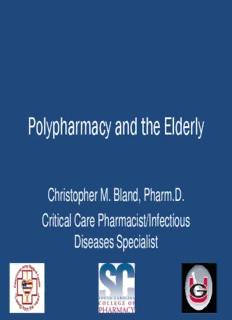
Polypharmacy and the Elderly - Internal Medicine | ACP PDF
Preview Polypharmacy and the Elderly - Internal Medicine | ACP
Polypharmacy and the Elderly Christopher M. Bland, Pharm.D. Critical Care Pharmacist/Infectious Diseases Specialist Objectives • Recognize factors leading to polypharmacy in the elderly • Define inappropriate medications for elderly patients • Describe tools to screen patients for polypharmacy • Describe best practices for limiting ADEs in “necessary” medications Patient Case • 74 year old female reports to her Coumadin clinic appointment. She was discharged from the hospital at 8:30 PM the previous night after being admitted for an episode of Afib with RVR. She pulls two different pill boxes out of her bag and states that she is totally confused. Patient Case continued • Looking exhausted she explains that she is totally confused and has no idea what she is supposed to be taking. Upon examination of her inpatient record you see that she was to stop her diltiazem due to severe constipation and begin Metoprolol which she was discharged on. Patient case continued • Upon inspection of her two pill planners you notice the Toprol XL and Diltiazem are both in her packs and she can’t really explain how she decides between the planners. • What factors contributed to her polypharmacy? Polypharmacy Definition • Wide range of definitions • No consensus definition • Generally defined as “Administration of more medications than clinically indicated, representing unnecessary drug use.” • Four or more medications used by many 1. Stewart RB et al. Drug Intelligence and Clinical Pharmacy 1990;24:321- 3. 2. Montamat SC et al. Clinics in Geriatric Medicine 1992;8:143-58. Pharmacokinetic Changes in Elderly • Hepatic blood flow drops by 40% • Half of elderly have some form of CKD • Heart failure patients can further exacerbate these decreases • First-pass clearance decreases in elderly – Warfarin – Benzodiazepines 1. Le Couteur DG, McLean AJ. Clin Pharmacokinet. – Opiates 1998;34(5):359-373. 2. Chadban SJ, Briganti EM, Kerr PG, et al. J Am Soc Nephrol. 2003;14(7 suppl 2):S131-S138. 3. Gottdiener JS, Arnold AM, Aurigemma GP, et al. J Am Coll Cardiol. 2000;35(6):1628-1637. Pharmacokinetics continued • Protein binding changes – Malnutrition – Dentures – Food preparation differences – Dietary restrictions • Substance abuse affecting metabolism – Up to 10% of elderly use significant alcohol 1. Pretorius RW et al. Am Fam Physician. 2013;87:331-6. 2. Adams WL, Cox NS. Int J Addict. 1995;30(13-14):1693- 1716.2 Growth of Elderly Population • Represent nearly 42 million – 13.3% of total population • Have increased 18% since 2000 • At 65th birthday have median life expectancy of 18-20 years • Over one-third of elderly received 90% of income from social security http://www.aoa.gov/Aging_St atistics/Profile/2012/2.aspx Elderly Population and Medications • Receive more than 50% of all prescription medications • More than 90% of non-institutionalized patients are on at least 1 Rx med • Most who engage in healthcare system take 6-8 medications • Comorbidities such as HTN, DM, Heart failure that require multiple medications Pretorius RW et al. Am Fam Physician. 2013;87:331-6
Description: